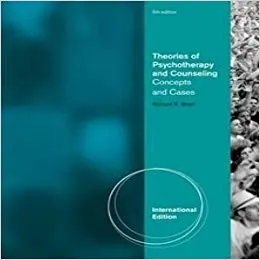Description
Theories of Psychotherapy & Counseling Concepts and Cases 5th Edition, International Edition by Richard S Sharf – Test Bank
EXAM QUESTIONS FOR
THEORIES OF PSYCHOTHERAPY AND COUNSELING: CONCEPTS AND CASES
FIFTH EDITON, RICHARD S. SHARF
Most of the multiple choice questions are about important concepts and their application. I have tried to vary the type of question and difficulty level. I have included a very few questions about details of cases described in the text. The numbers next to the answer indicate that it is the correct answer and show on what page of the text it can be found. A few correct answers have no specific page reference and correct answers are indicated with an *. Instructors may wish to change the order in which the questions are presented, as the order sometimes gives a clue to the correct answer. Typically, I have listed them in the order that they occur in the text. Questions comparing one theory to another will be found throughout. However, questions from Chapter 16 include only questions that compare one theory with another. Perhaps the best instructions are: Please choose the best answer from the choices that are given. Students may view practice questions on the Cengage*Brooks/Cole website for students. There are 10 questions for each chapter. None will be repeats of these questions.
Please remember to delete the page numbers when creating a test!
CHAPTER 1
INTRODUCTION
- Theories of any type should be based on
- clear rules. (2)
- many assumptions.
- a unique plan.
- unrelated laws or relationships.
- The term “counseling”
- does not differ consistently from “psychotherapy”. (4)
- is used to differentiate types of mental health professionals.
- refers to helping people with educational and vocational concerns.
- refers to helping people with normal problems.
- The term “psychotherapy”
- does not differ consistently from “counseling”. (4)
- is used to differentiate types of mental health professionals.
- refers to helping people with educational and vocational concerns.
- refers to helping people with normal problems
- The most commonly identified approach to psychotherapy is
- behavioral.
- cognitive.
- integrative. (4)
- psychoanalytic/psychodynamic.
- Which of these statements is a factor common to all therapies?
- The relationship between client and therapist is important for progress. (10)
- The therapist should be integrative.
- The therapist should be trained in psychoanalysis.
- The therapist should be able to give good advice.
- An individual who is very talkative and distractible may be exhibiting behavior best described as
- anxious.
- compulsive.
- manic. (13)
- unpredictable.
- Mary has difficulty getting up in the morning and has little desire to do her school work. This could be an indication of
- borderline personality disorder.
- depression. (13)
- generalized anxiety disorder.
- a phobia.
- Abigail has had several brief romantic relationships, all ending in disappointment as she has felt that her lovers did not live up to her expectations. This is most likely an indication of a (an)
- borderline personality disorder. (14)
- depression.
- generalized anxiety disorder.
- obsessive-compulsive disorder.
- A re-occurring thought that one will die at the age of 46 is an example of
- anxiety.
- compulsions.
- phobias.
- obsessions. (14)
- When headaches can not be traced to any known physiological cause they may be most likely symptoms of
- anxiety disorder.
- conversion reaction.
- posttraumatic stress disorder.
- somatoform disorder. (15)
- John feels that people at work should appreciate him and realize he is the reason his company is successful, although he has little concern about his fellow employees and their problems.. This may be a symptom of a(an)
- borderline personality disorder.
- phobia.
- narcissistic personality disorder. (15)
- somatoform disorder.
- Belinda hears the voice of William Shakespeare communicating with her about her writing. She may be suffering from
- an anxiety disorder.
- a borderline disorder.
- neurosis.
- schizophrenia. (16)
- Kalinda has been eating 300 calories of food per day for the past year. She is suffering from:
- anorexia. (15)
- bulimia.
- a somatoform disorder.
- posttraumatic stress.
- Which of these statements best describes research supported psychological treatments? Research supported psychological treatments refer to therapies that
- are based on treatments supported by scientific investigation. (18)
- are multicultural in their approach.
- are recommended by all theories of therapy.
- uncover the unconscious.
- Research supported psychological treatments
- are based on studies of the effectiveness of psychotherapy. (18)
- are multicultural in their approach.
- are only used by cognitive and behavioral therapists.
- are only used with individuals with phobias.
- The position that there is a fixed truth rather than perceptions of reality or truth is associated with
- constructivism.
- modernism. (19)
- postmodernism.
- social constructivism.
- Focusing on the perceptions of the client rather than the therapist’s view of the problem is most consistent with
- constructivism. (19)
- modernism.
- feminism.
- colonialism.
- A researcher studies a group of depressed patients for 5 years to determine the effectiveness of therapy. Her research can be criticized for failing to
- define the group to be studied.
- do a follow up study.
- have a control group. (21)
- perform a meta-analysis.
- Ethical codes should be
- irrelevant to the practice of psychotherapy theory.
- different for different psychotherapy theorists.
- followed in the practice of theories of psychotherapy. (23)
- identical across all mental health professions.
- Ethical codes apply
- only to psychoanalytic therapies.
- only to behavior therapies.
- only to humanist therapies.
- to all therapies. (23)





Be the first to review “Theories of Psychotherapy & Counseling Concepts and Cases 5th Edition, International Edition by Richard S Sharf – Test Bank”